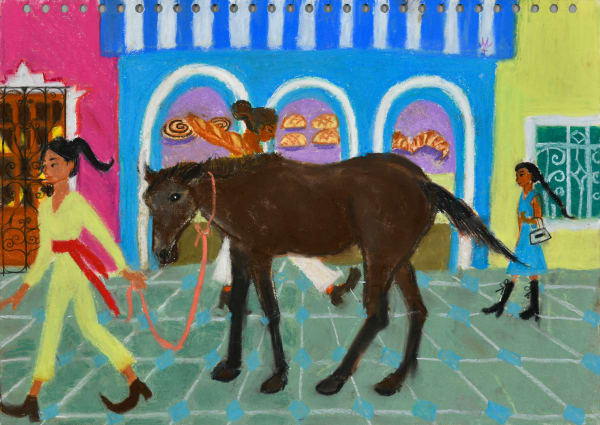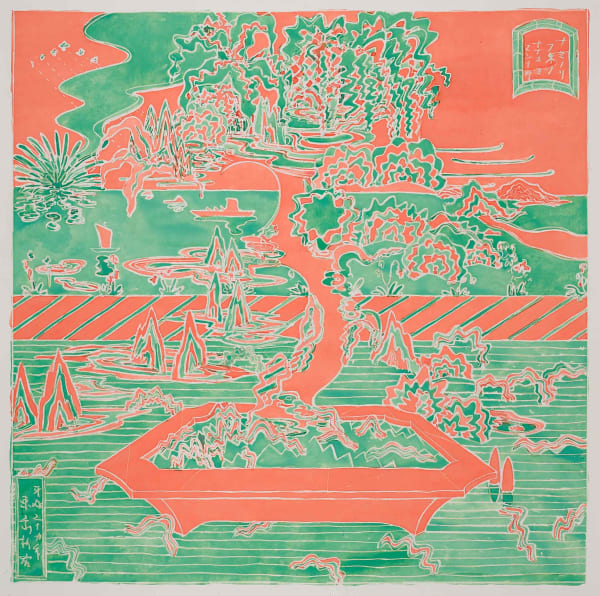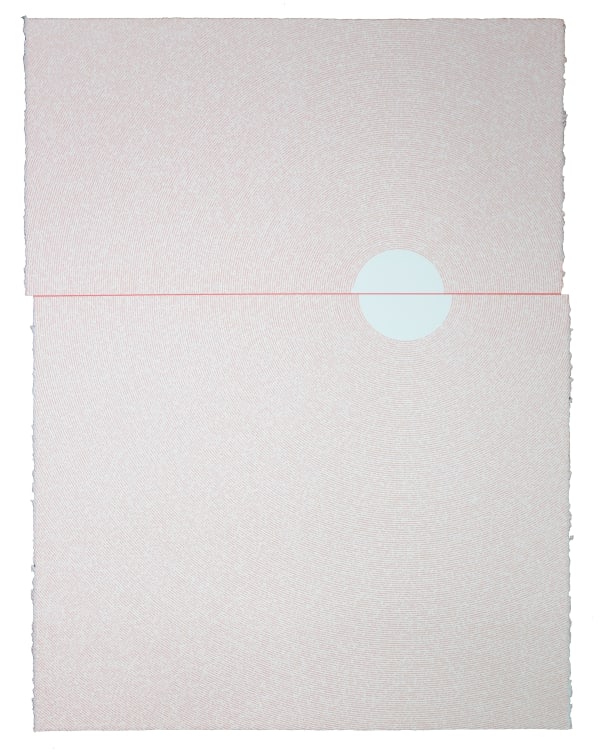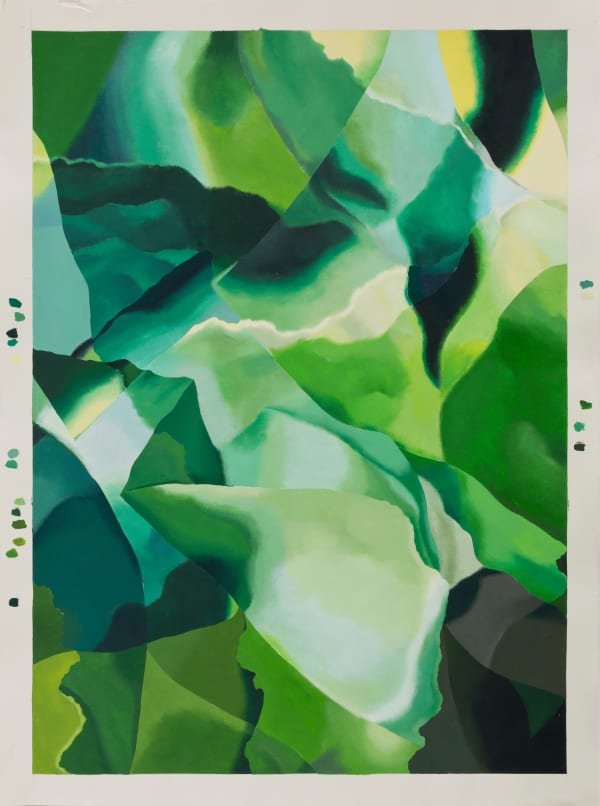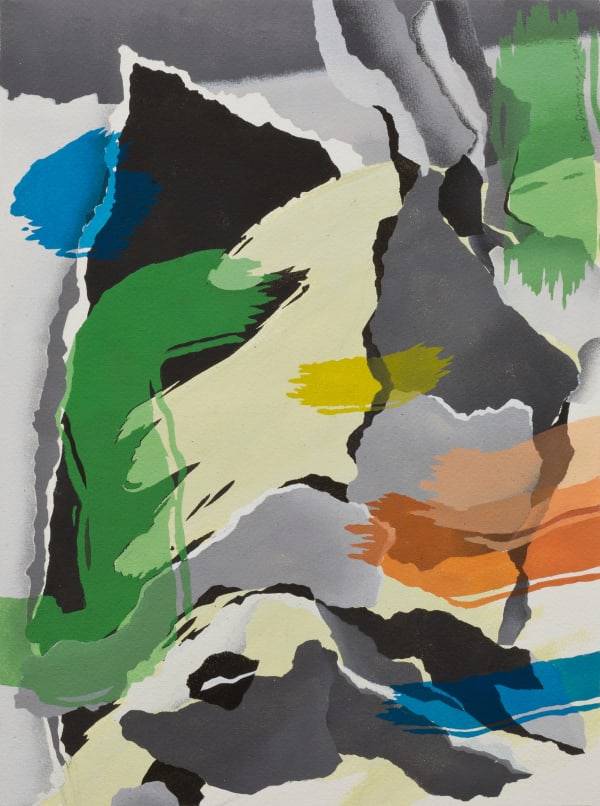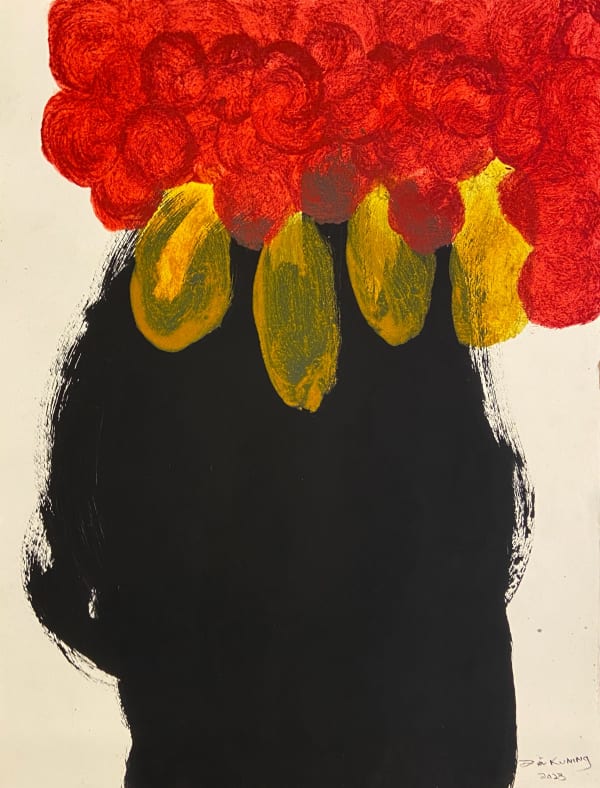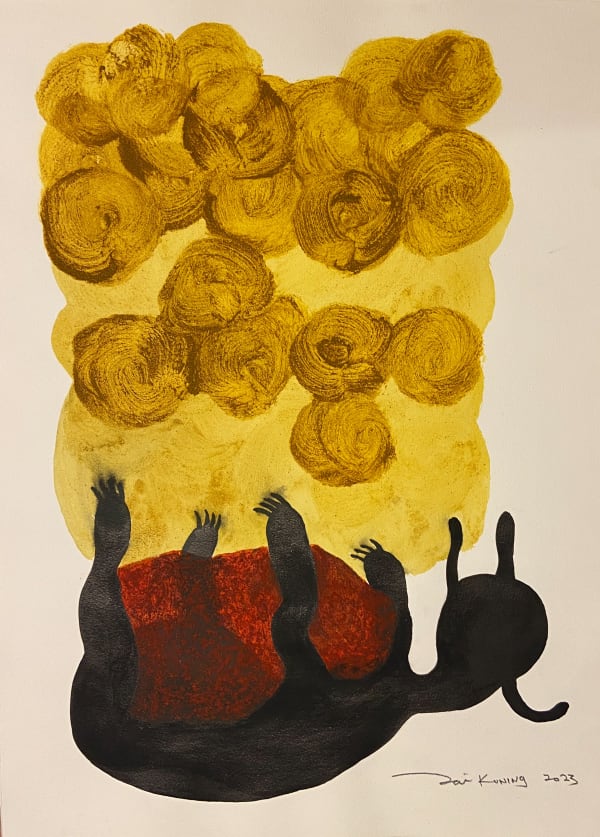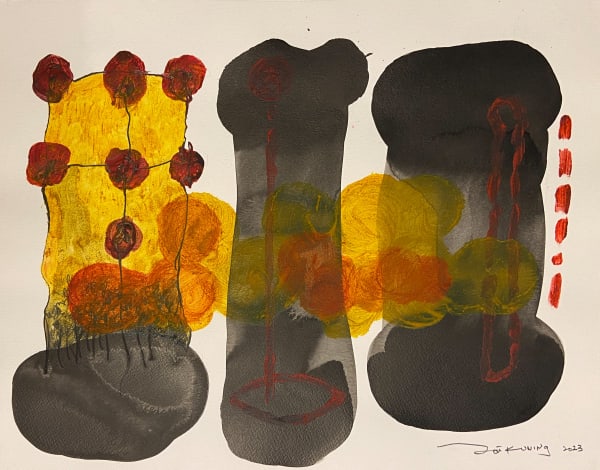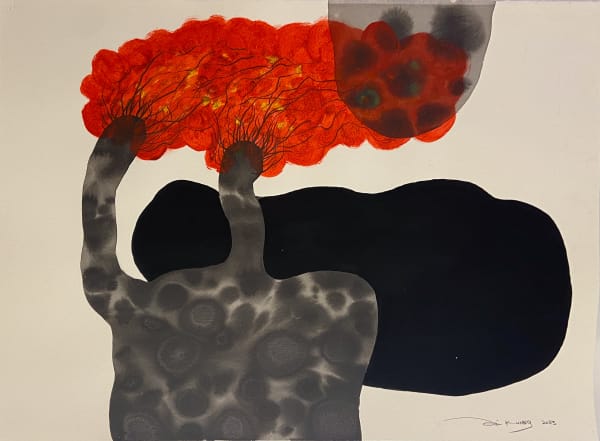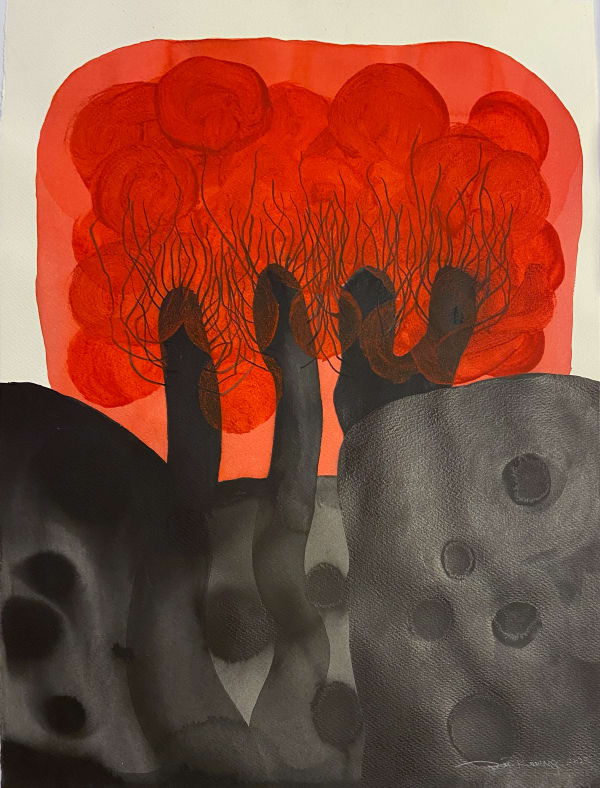Works on Paper: Maria Farrar, Masanori Handa, Tsuyoshi Hisakado, Zai Kuning, Yayoi Kusama, Nobuaki Takekawa, Tang Dixin, Xu Danqing
Ota Fine Arts Singapore is delighted to present "Works on paper", a group exhibition including works by Maria Farrar, Masanori Handa, Tsuyoshi Hisakado, Zai Kuning, Yayoi Kusama, Nobuaki Takekawa, Tang Dixin, and Xu Danqing. From abstract to figurative, bright to soft colour palettes, and a mix of different mediums, this exhibition features a wide variety of works on paper by the gallery’s represented artists.
Depicted in Maria Farrar’s (b. 1988, Philippines) figurative drawings are scenes derived from her everyday life or from fragments of memories. Be it passing by a pastry shop or gazing into a dress shop, each captured moment is concrete and yet at the same time, contains a sense of elusiveness and the feeling of a floating and expanding world. Through her visual compositions, Farrar explores the relationship between female self-presentation, materiality, and desire. Contrastingly, Nobuaki Takekawa (b. 1977, Japan) incorporates accessible and light-hearted motifs to discuss underlying issues in our contemporary society. Mynah Birds in Hawker Center (2020) was inspired by his observation of the environment and city life in Singapore during his 11-day residency in the country. Dressed in various ethnic costumes, the mynah birds (commonly found locally) reflect the social interactions between different communities in a multicultural state like Singapore.
Straddling the line between figurative and abstract are new drawings from Tang Dixin (b. 1982, China) whose surreal imagery of the human body brings about a sense of tension and absurdity. Underlying this is a social commentary on the image and concept of the "body", which is oppressed in the Chinese society and art world. Also presented in this exhibition are works from Masanori Handa’s (b. 1979, Japan), "nakakiyono entakukei" series of drawings which are an extension of his installation piece of the same title, inspired by a traditional Japanese poem that describes a sea voyage coupled with the comfortable sounds of waves, and dozing away in the middle of the ocean on a long night as if it will never end. Handa re-imagines the scenes described in this poem for his work, resulting in a playful and impressionistic, yet nonetheless contemplative depiction.
On the other hand, works by Xu Danqing (b. 1987, China) whose exploration of human nature brings her creative vision into the world of mysticism where she creates the visual feeling of smell, rhythm and colors that cannot be quantified in a logical way. Fragrance Poetry (2017) was inspired by Xu’s impression of a rose - the most poetic flower whose scent still has a lingering and profound impact on her memories. Moving towards a more primal portrayal of human nature through abstraction, are new works from Zai Kuning (b. 1964, Singapore). Zai has always been interested in the relationship between man and the environment. These works in particular explore the relationship between the Orang Laut and the sea. The prominent use of black ink with blobs of bright reds, the occasional yellows, and floating tendrils in his Secrecy of Plant in Darkness (2023) series, highlights man’s monstrous imagination of the sea and how it can instill both fear and peace within us.
Last but not least, the use of patterns and repetition can be seen in the works of Yayoi Kusama (b. 1929, Japan) and Tsuyoshi Hisakado (b. 1981, Japan). Kusama’s obsession with the infinite repetition of patterns of objects is reflected in her prints which depict repeated motifs of eyes, women’s profiles and dots on single-coloured bases covered in bold colours of red, yellow, green and blue. Comparatively, Hisakado whose practice explores concepts of space and time, but with a focus on the seemingly mundane aspects of everyday life, takes a more subtle approach. In his crossfades #4 works, an infinite series of numerals derived from the mathematical constant pi (π) are silkscreen printed on paper in a spiral pattern, alluding to concepts of time and infinity. At first glance, one would not be able to notice the intricate patterns that appear in these works. It is only when the viewer takes a closer look that they will be able to spot them.
Ota Fine Arts Singapore invites all to experience the variety and uniqueness that each artist brings to this exhibition through their works!
-
![Yayoi Kusama Days When I Am Alive, 2012 Silkscreen [4 colors] + etching embossing 60 x 72 cm [Image] / 84 x 94 cm [Paper] Edition of 30](data:image/gif;base64,R0lGODlhAQABAIAAAAAAAP///yH5BAEAAAAALAAAAAABAAEAAAIBRAA7) Yayoi KusamaDays When I Am Alive, 2012Silkscreen [4 colors] + etching embossing60 x 72 cm [Image] / 84 x 94 cm [Paper]Edition of 30
Yayoi KusamaDays When I Am Alive, 2012Silkscreen [4 colors] + etching embossing60 x 72 cm [Image] / 84 x 94 cm [Paper]Edition of 30 -
 Tang DixinDance 1, 2023Ink on paper37.8 x 28.3 cm
Tang DixinDance 1, 2023Ink on paper37.8 x 28.3 cm -
 Tang DixinDance 2, 2023Ink on paper27.6 x 37.8 cm
Tang DixinDance 2, 2023Ink on paper27.6 x 37.8 cm -
 Nobuaki TakekawaMynah Birds in Hawker Center, 2020Watercolour and ink on paper115.5 x 140.7 cm
Nobuaki TakekawaMynah Birds in Hawker Center, 2020Watercolour and ink on paper115.5 x 140.7 cm -
 Maria FarrarHacienda Uayalceh, 2022Pastel on paper28.7 x 40.4 cm
Maria FarrarHacienda Uayalceh, 2022Pastel on paper28.7 x 40.4 cm -
 Maria FarrarStretching Fox, 2022Pastel on paper40.5 x 30.6 cm
Maria FarrarStretching Fox, 2022Pastel on paper40.5 x 30.6 cm -
 Masanori Handauramabuta no hana, 2017Watercolour, oil pastel on paper108 x 108 cm
Masanori Handauramabuta no hana, 2017Watercolour, oil pastel on paper108 x 108 cm -
 Masanori Handanaminorifuneno, 2017Watercolour, oil pastel on paper108 x 108 cm
Masanori Handanaminorifuneno, 2017Watercolour, oil pastel on paper108 x 108 cm -
 Masanori Handatoononefurino, 2016Watercolour, oil pastel on paper110 x 110 cm
Masanori Handatoononefurino, 2016Watercolour, oil pastel on paper110 x 110 cm -
 Masanori Handai, 2017Watercolour, oil pastel on paper108 x 108 cm
Masanori Handai, 2017Watercolour, oil pastel on paper108 x 108 cm -
 Tsuyoshi Hisakadocrossfades #4 / collapse xvii (sunset), 2020Silkscreen, ink on paper76.5 x 56 cm
Tsuyoshi Hisakadocrossfades #4 / collapse xvii (sunset), 2020Silkscreen, ink on paper76.5 x 56 cm -
 Tsuyoshi Hisakadocrossfades #4 / world v (dusk), 2020Silkscreen, ink on paper76.5 x 56 cm
Tsuyoshi Hisakadocrossfades #4 / world v (dusk), 2020Silkscreen, ink on paper76.5 x 56 cm -
 Xu DanqingGreen 2, 2020Acrylic paint on watercolor paper76 x 56 cm
Xu DanqingGreen 2, 2020Acrylic paint on watercolor paper76 x 56 cm -
 Xu DanqingMirror, 2020Acrylic paint on watercolor paper76 x 56 cm
Xu DanqingMirror, 2020Acrylic paint on watercolor paper76 x 56 cm -
 Xu DanqingHare, 2017Acrylic paint on watercolor paper
Xu DanqingHare, 2017Acrylic paint on watercolor paper
39 x 27 cm -
 Xu DanqingFragrance Poetry, 2017Acrylic paint on watercolor paper39 x 27 cm
Xu DanqingFragrance Poetry, 2017Acrylic paint on watercolor paper39 x 27 cm -
 Zai KuningSecrecy of Plant in Darkness 8, 2023Batik dye, turmeric, chilli powder and acrylic on paper58.5 X 45 cm
Zai KuningSecrecy of Plant in Darkness 8, 2023Batik dye, turmeric, chilli powder and acrylic on paper58.5 X 45 cm -
 Zai KuningWe Are Home And Everywhere 4, 2023Batik dye, turmeric, chilli powder and ink on paper58.8 x 43.1 cm
Zai KuningWe Are Home And Everywhere 4, 2023Batik dye, turmeric, chilli powder and ink on paper58.8 x 43.1 cm -
 Zai KuningBrutality of Fact 2, 2023Batik dye, turmeric, chilli powder, pencil and ink on paper38.4 x 49 cm
Zai KuningBrutality of Fact 2, 2023Batik dye, turmeric, chilli powder, pencil and ink on paper38.4 x 49 cm -
 Zai KuningBurning Spring in Monsoon, 2023Batik dye, turmeric, chilli powder, acrylic, pencil and ink on paper56.5 x 75.5 cm
Zai KuningBurning Spring in Monsoon, 2023Batik dye, turmeric, chilli powder, acrylic, pencil and ink on paper56.5 x 75.5 cm -
 Zai KuningSecrecy of Plant in Darkness 11, 2023Batik dye, chilli powder, pencil and ink on paper75.7 x 56 cm
Zai KuningSecrecy of Plant in Darkness 11, 2023Batik dye, chilli powder, pencil and ink on paper75.7 x 56 cm
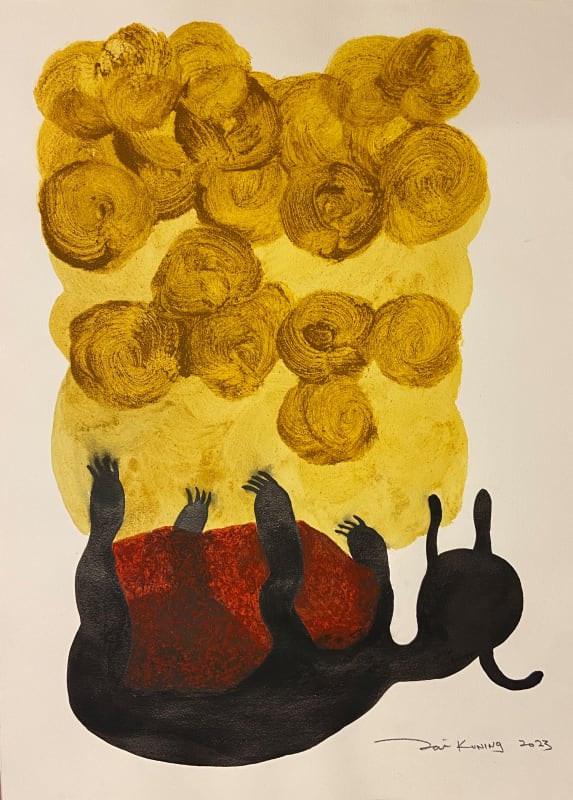
![Yayoi Kusama Days When I Am Alive, 2012 Silkscreen [4 colors] + etching embossing 60 x 72 cm [Image] / 84 x 94 cm [Paper] Edition of 30](https://artlogic-res.cloudinary.com/w_600,c_limit,f_auto,fl_lossy,q_auto/artlogicstorage/otafinearts/images/view/519893183b8cfb744b6910130057462ej/otafinearts-yayoi-kusama-days-when-i-am-alive-2012.jpg)



